Physical Address
304 North Cardinal St.
Dorchester Center, MA 02124
Physical Address
304 North Cardinal St.
Dorchester Center, MA 02124
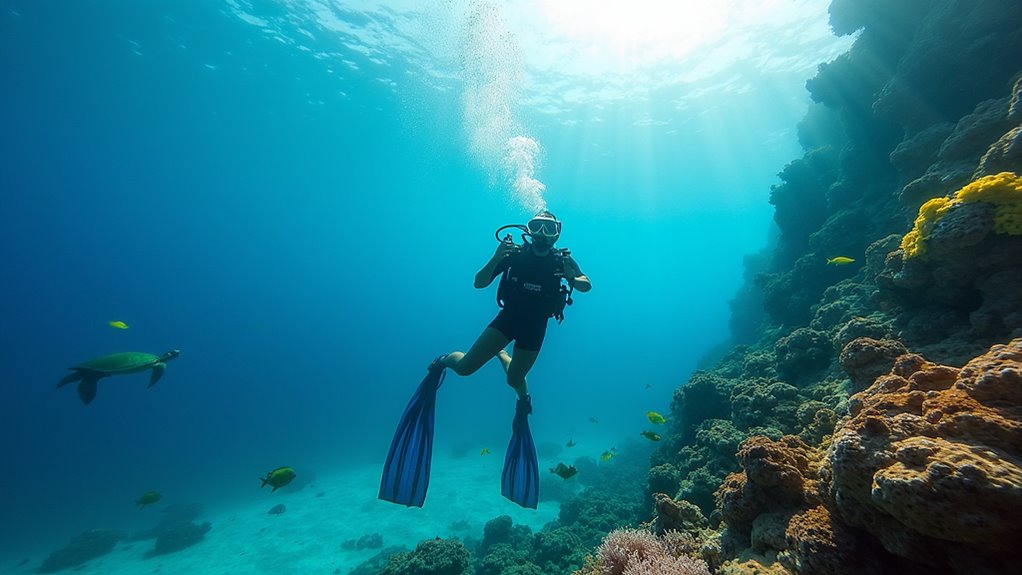
Known for vibrant coral gardens and close turtle encounters, Gili Trawangan's dive sites offer underwater magic that will leave you breathless.
Imagine drifting effortlessly above vibrant coral gardens while a green turtle glides past, just an arm’s length away. You’ll find this underwater magic in Gili Trawangan, the largest of Indonesia’s three Gili Islands. Whether you’re a novice or certified diver, these waters offer crystal-clear visibility and an astonishing variety of marine life. From the famous Shark Point to the tranquil Turtle Heaven, each dive site presents its own unique underwater landscape. Ready to discover which site might become your personal favorite?
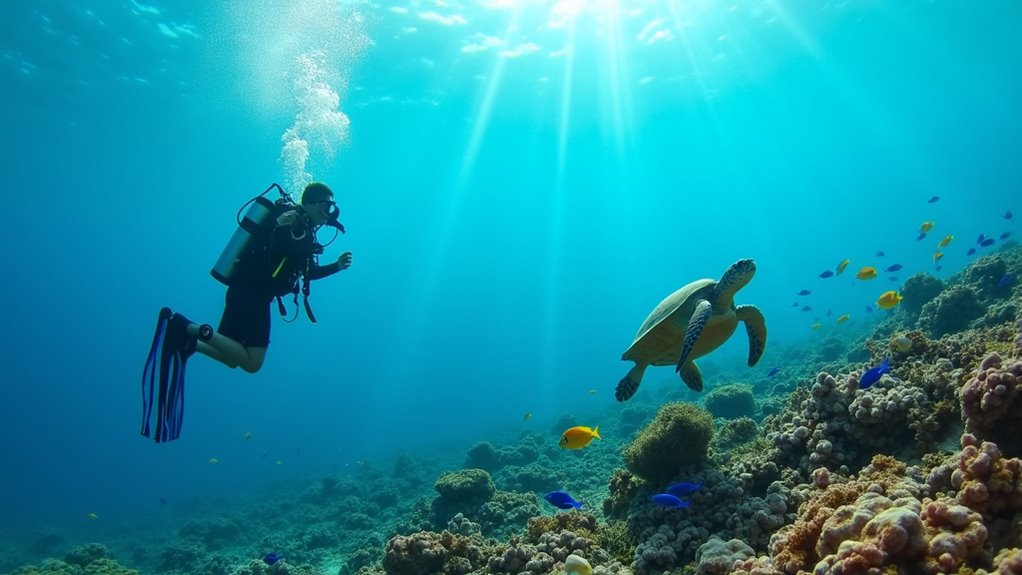
Nestled within the famed Coral Triangle, the Gili Islands offer dive experiences that few destinations can match. You’ll be exploring waters that host an astonishing 17% of the world’s wildlife and 35% of all reef fish species.
Year-round diving is possible thanks to warm equatorial waters (26-29°C) with visibility typically ranging from 15-30 meters. Whether you’re spotting green turtles near Gili Meno or encountering elusive blacktip reef sharks around Trawangan, you’re witnessing Indonesia’s remarkable marine biodiversity firsthand. The must-visit destination status of the Gili Islands is well-earned, with their pristine waters being a major draw for travelers worldwide.
The islands’ diverse dive sites cater to all certification levels, with depths between 5-30 meters. Strong currents at sites like Shark Point attract larger pelagic species, while gentler locations like Han’s Reef showcase stunning soft and hard coral formations where clownfish, angelfish, and butterflyfish abound. Once you’ve finished diving, you can enjoy Gili Trawangan’s lively nightlife with its diverse restaurants and bars that make it popular among young travelers.
Gili Trawangan’s surrounding waters offer five exceptional dive sites that showcase the island’s marine diversity. At Shark Point, you’ll find options for all skill levels with regular reef shark sightings and a 30m tugboat wreck.
Explore Gili Trawangan’s underwater paradise, where reef sharks cruise and a sunken tugboat beckons divers of every level.
Halik Reef features steep-slope drift diving where barrel sponges and gorgonian sea fans create dramatic backdrops for bumphead parrotfish and eagle rays. This northwest site drops to 40 meters and offers excellent opportunities to observe schooling fish species during full moon periods.
Beginners shouldn’t miss Manta Point, where seasonal manta rays (April-October) glide above dense coral fields in a current-free cove. The pristine visibility here resembles the underwater beauty found at Bali’s top snorkeling destinations.
Turtle Heaven lives up to its name with the highest turtle concentration around Gili, perfect for novice divers at 8-15m depths.
For the adventurous, Deep Turbo delivers advanced thrills with strong currents, vertical walls, and pelagic action including trevally and rare black corals.

Because it’s situated in the heart of the Coral Triangle, Gili Trawangan’s waters teem with extraordinary marine biodiversity you won’t find in many other dive destinations. You’ll regularly encounter clownfish, angelfish, and colorful reef dwellers like parrotfish and butterflyfish darting among vibrant coral formations.
Green and hawksbill turtles are abundant year-round, while moray eels and lionfish hide within reef crevices. Night dives reveal octopus, cuttlefish, and mantis shrimp.
Lucky divers might spot bamboo sharks in sandy areas or manta rays in deeper channels during seasonal migrations. The region has been aptly nicknamed the “Turtle Capital of the World” due to its consistent and plentiful turtle sightings. If you’re planning an extended Indonesian adventure, consider land travel options from Bali to Jakarta after your diving expedition.
Conservation challenges persist—coral bleaching and tourism pressure threaten this delicate ecosystem. Blacktip and whitetip reef sharks appear occasionally, though shark populations face pressure from overfishing.
For macro enthusiasts, nudibranchs and symbiotic anemone communities offer fascinating underwater photography subjects.
Planning your Gili Trawangan diving adventure requires understanding when you’ll find the best underwater conditions. The dry season (May-October) delivers peak visibility of 25-35 meters, with June-August offering the calmest seas during peak tourist season.
If you’re hoping to spot mantas or whale sharks, visit during the wet season (November-April) when plankton blooms attract larger marine life. However, visibility drops to 10-25 meters during this time. Many divers prefer the peak diving months of May/June and October/November when water clarity and marine activity balance perfectly.
The Gilis enjoy milder wet seasons than mainland Lombok thanks to local microclimates. Beyond marine life, lucky divers might occasionally spot some of Bali’s native animals swimming near the islands’ shores.
Water temperatures remain comfortable year-round (28-29°C), and dive operators maintain consistent schedules regardless of season.
For fewer crowds and better rates, consider the March-June shoulder season.
Advanced divers seeking drift experiences should target September-October when currents intensify around Halik Reef and Shark Point.
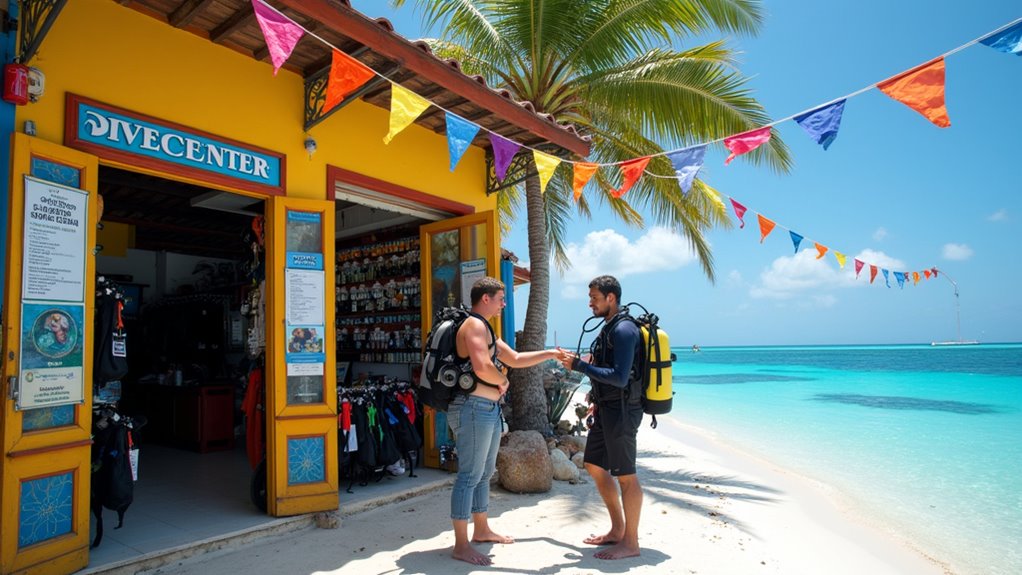
Selecting the right dive center in Gili Trawangan can make or break your underwater experience, as each offers different specialties despite similar pricing across the island. With uniform rates, focus on value rather than cost comparisons.
Consider group size—smaller operations like Mango Dive offer more personalized attention. Check staff-to-diver ratios (aim for 1:4 or better) and verify safety protocols including on-site oxygen and first-aid certifications. Beyond diving, Gili Trawangan offers opportunities to try other adventure activities popular throughout Bali.
Your dive site priorities matter too. Centers near the northwest coast provide easier access to Shark Point, while eastern-based shops like Ko Ko Mo Resort excel for Stingray’s biorock reefs.
Don’t overlook equipment quality and maintenance records.
Finally, research environmental practices—the best centers emphasize reef conservation and proper buoyancy training to protect Gili’s fragile marine ecosystem. Most of the approximately 15-20 dive shops on the island adhere to price agreements, ensuring you won’t find significant cost differences between operators.
While many travelers visit Gili Trawangan for snorkeling, earning a formal scuba certification opens up a whole new underwater world that casual visitors never see. Both PADI and SSI offer beginner certifications that qualify you to dive up to 18 meters independently after completing theory sessions, pool training, and four open-water dives around the Gili islands. Trawangan Dive, the first PADI CDC in the entire Lombok Region, provides comprehensive certification options with their award-winning team of instructors.
You’ll need to pass a basic swim test (200-meter swim and 10-minute float) and complete a medical questionnaire. After a day of diving, many divers enjoy Balinese massage therapy to help soothe tired muscles and enhance relaxation.
If you’re under 15, you can still get certified with a Junior Open Water certification, which automatically upgrades when you turn 15.
For those passionate about marine conservation, look for dive centers offering ECO courses or coral restoration programs that combine certification with environmental protection.
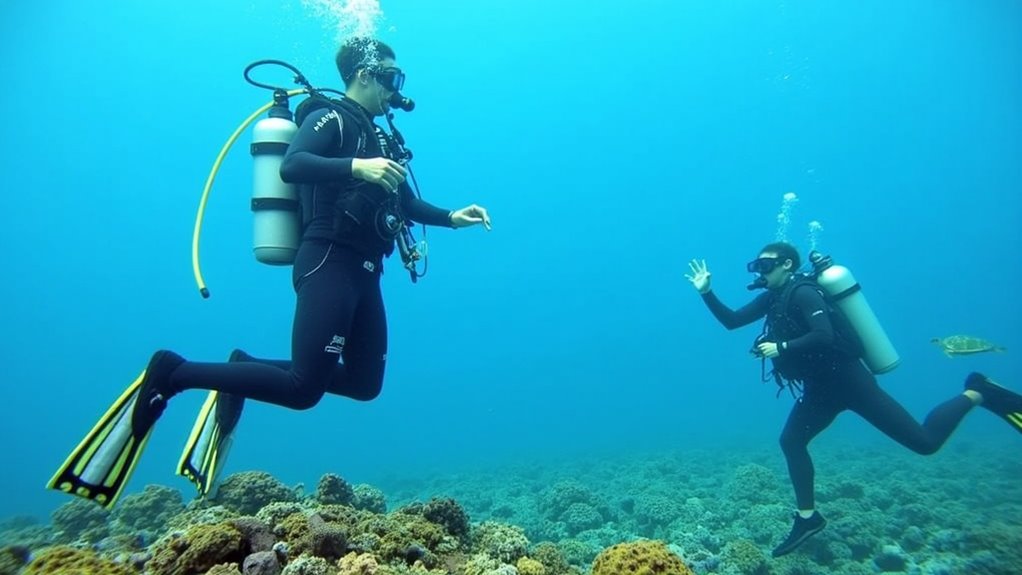
Once you’ve decided to earn your certification, understanding safety protocols becomes the foundation of your underwater adventures in Gili Trawangan. Choose dive centers with accredited professionals, well-maintained equipment, and emergency oxygen supplies.
Before diving, ensure your guide knows the site conditions and carry essential safety gear: reel, SMB, whistle, and flashlight. For technical diving beyond 40 meters, you must complete dive plans and have them approved by Trawangan Tech staff. Always analyze and label your gas mixes, and follow maximum PO2 limits for both bottom and decompression phases.
The best diving months are May, June, October, and November when visibility is ideal. With water temperatures averaging 28°C, you’ll enjoy comfortable dives while observing abundant marine biodiversity. If you’re looking to combine your diving trip with other experiences, consider a day trip to Nusa Dua for its luxurious resorts and pristine beaches.
After you’ve mastered the underwater basics, getting to Gili Trawangan becomes your next challenge. Fast boats from Bali are your primary option, with operators like BlueWater Express (790,000 IDR) and Eka Jaya (350,000 IDR) departing from Padang Bai or Sanur.
Book tickets several days ahead during peak season. If you’re coming from Lombok, head to Bangsal Harbor for public ferries or speedboats that reach the Gilis in about 30 minutes. While exploring the islands, travelers should be aware that venomous snakes species are rare but present in some coastal areas of Bali and surrounding islands.
Once on the islands, forget cars and motorbikes—they don’t exist here. You’ll navigate via cidomo (horse carriages), bicycles (50,000-100,000 IDR/day), or your own two feet. The recent introduction of electric scooters provides an eco-friendly alternative for getting around quickly.
Most accommodations offer free cidomo pickup from the harbor, and Gili Trawangan’s dive sites are just 10-20 minutes apart by walking.
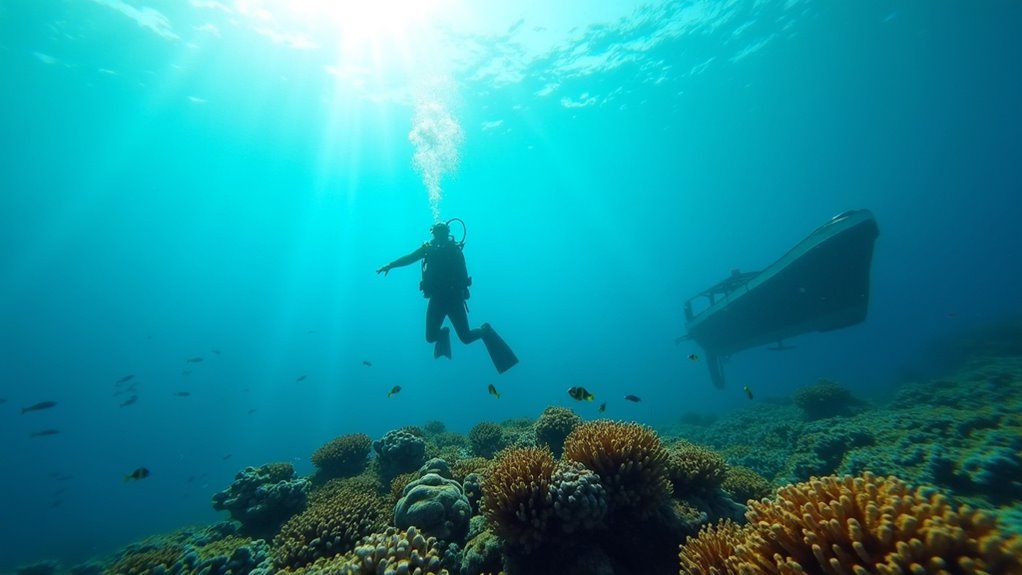
Finding the right place to stay and eat in Gili Trawangan can be just as important as choosing your dive operator. Accommodation ranges from $20 hostels to $100+ luxury villas, with mid-range options averaging $36-$75 nightly. Remember that prices nearly double during high season, so book 2-3 months ahead for best rates.
Many hotels cater specifically to divers with gear storage, rinse tanks, and dive trip arrangements. For convenience, stay within a 5-minute walk of dive centers—north coast for turtle sightings, southwest for nightlife access. Highly-rated Marygio Resort offers spacious rooms with amenities and is within walking distance of island attractions. The island is part of the larger Java experience that many travelers consider essential when exploring Indonesia.
When hunger strikes, you’ll find local warungs serving Indonesian classics under $5, beachfront cafes offering $10-15 meals, and night markets where $3 buys fresh grilled seafood. Most dive-friendly hotels include breakfast, helping stretch your budget further.
With your accommodations and meals squared away, you’re ready to explore the underwater marvels of Gili Trawangan through various excursion options.
Single-day packages offer excellent value at around $69 USD, including two dives, beach club access, and transport coordination. Non-divers can join as snorkelers on the same boats. Beginners can integrate PADI courses as add-ons.
For serious dive enthusiasts, multi-day packages provide flexibility to spread 5-10 dives over several days with tiered pricing ($30-38 USD per dive depending on quantity). All packages include complete equipment rental for your convenience, eliminating any concerns about bringing or purchasing gear. Night dives ($46 USD) run periodically, while group discounts apply for parties of four or more.
Remember the mandatory marine park fee (~$10 USD) and plan for the 4:1 diver-to-guide ratio.
With year-round 27-30°C waters and 15-30m visibility, you’ll enjoy drift dives, wrecks, and vibrant marine life. After a long day of diving, you might want to treat yourself to a fresh new look at one of Bali’s barber shops before heading out for evening activities.
You’ll leave Gili Trawangan with salt in your hair and wonder in your heart. As you drift through crystal waters, surrounded by darting fish and ancient turtles, you’re not just diving—you’re discovering a hidden universe. Pack your masks, respect the reefs, and prepare for magic. The Gilis aren’t just another stamp in your logbook; they’re the underwater memories that’ll flash through your mind on ordinary days long after you’ve gone home.